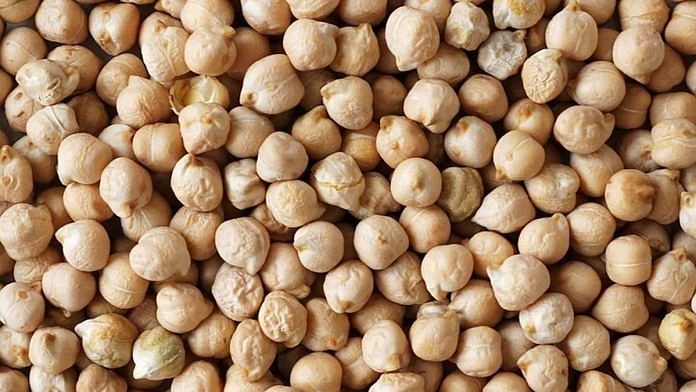New Delhi: Research led by scientists from International Crops Research Institute for the Semi-Arid Tropics (ICRISAT) in India is set to help produce more chickpea or chana, and make it more nutritious and climate-change resistant.
The worldwide research project has made it possible to cultivate new varieties of one of the most consumed pulses in the world, in a number of forms. These varieties are expected to give increased yields of chana at about similar input costs to current varieties, and the new crop is set to be less susceptible to damage, as well as tastier.
The scientists used genome sequencing to produce these new varieties, and made a knowledge bank that can be used for experiments to produce better chana in future. The research, the world’s largest on plant genome sequencing, was published earlier this week in the science journal Nature.
Genome sequencing is a method used to determine the entire genetic makeup of an organism. The genetic study of crop varieties is then used for further improvement by scientific research and biotechnological methods.
The scientists, led by Prof. Rajeev Varshney, research programme director for accelerated crop improvement at ICRISAT, mapped the genomic sequence of chana crops from across the world by sequencing 3,366 varieties from 60 countries. Of these, 3,171 were cultivated, while 195 were wild species.
In total, 29,870 genes were identified, out of which 1,582 were previously unreported genes. The research also provided the historical origins of chana and the migratory paths the crop as it spread around the globe.
After this study, chana is among a club of crops like rice, wheat and maize for which there’s extensive genetic information, enabling future advances through applied genetic technology.
Also read: Cherry tomatoes are 80,000 yrs old. No humans were domesticating plants that long ago
Past and future of chana
ICRISAT’s statement on the study says chickpea is grown in more than 50 countries and is the world’s third-most cultivated legume. It is indispensable to the diets in many nations and is an important source of dietary protein, especially in the global South.
Study leader Varshney told ThePrint that this project began in 2014, and took three years to generate the data, and another three to analyse and interpret it. Then, it took one-and-a-half years or so to publish it in Nature.
“Through genome sequencing, we have been able to affirm the history of chickpea’s origin in the Fertile Crescent and identify two paths of diffusion or migration of chickpea to the rest of the world,” Varshney told ThePrint. The Fertile Crescent’ is the swathe of area in West Asia that is home to some of the world’s earliest civilisations.
“There were some chickpea seeds of wild species during the Mesopotamian civilisation in the Middle East, which were picked up and cultivated by humans,” Varshney said. “One path indicates diffusion to South Asia and East Africa, and the other suggests diffusion to the Mediterranean region as well as to the Black Sea region and central Asia.”
According to Trilochan Mahapatra, director general, Indian Council of Agricultural Research and an author of the study, the demand for chickpea is set to increase in the coming years as the world’s population rises.
“Research like this is the need of the hour to help major chickpea-producing countries like India boost production while making crops climate-resilient,” said Mohapatra.
Varshney added that this is what the eventual goal of the study is.
“We have also delved deep into the science behind the chana crop, and this will change the landscape of its breeding. The next step is for breeders to be trained to use the information for crop improvement. In the coming years, with climate change, there’ll be higher temperatures and more droughts, so we need to have more resilient, high-yielding varieties that are extremely nutritious at the same time,” he said.
Purging ‘bad genes’
Apart from further refinement of the crop, the study can be used to identify misclassification or duplication in genebanks. It can also help to identify various deleterious genes (defective genes that can make a crop susceptible to diseases) responsible for lowering crop performance. It can then be further purged, using genomics-assisted breeding or gene editing.
The study identified blocks of genes called ‘Haplotypes’ that can significantly enhance the performance of the crop by improving traits like yield, climate resilience and seed characteristics. To take the study’s findings to the farm, the authors have proposed various breeding approaches based on genomic prediction aimed at improving 16 traits of the chana and enhancing its productivity.
“We have analysed that by applying these approaches we can enhance the ‘100-seed weight’ — a critical yield trait — by 12-23 per cent, thereby increasing overall yield. We also advocate that rather than being adamant on only introducing good genes into improved varieties, bad genes should be purged parallelly to improve overall yield and crop quality,” Varshney said.
(Edited by Saikat Niyogi)
Also read: IndiGen project — how mapping of genomes could transform India’s healthcare



